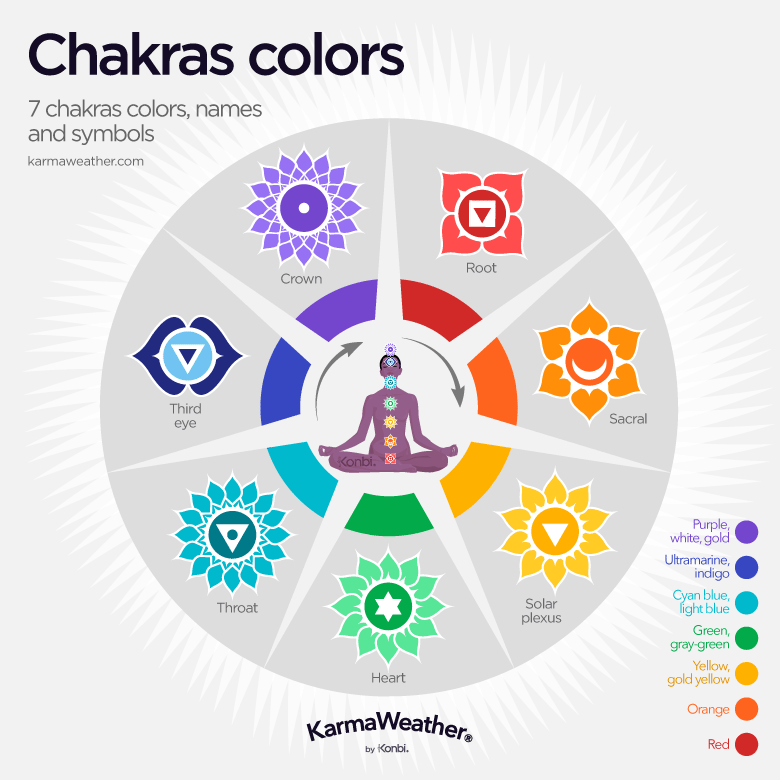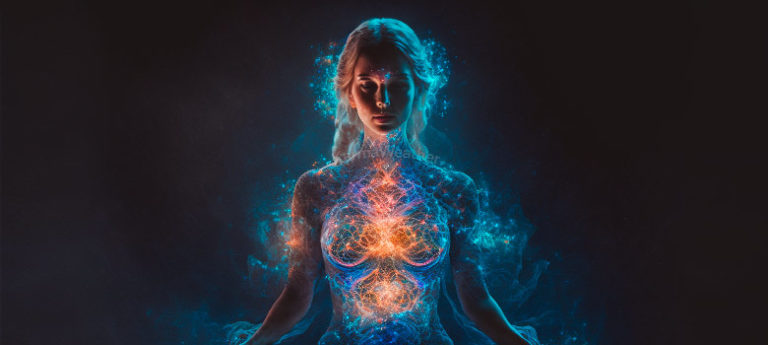The 7 Chakras - Meaning, Origin, Colors
© KarmaWeather by Konbi - All rights reserved
What are the origin, meaning, symbols and colors of the 7 chakras, the root, sacral, solar plexus, heart, throat, third eye and crown chakras?
A brief history of the 7 chakras
According to the Hindu tradition, every living being contains in him incalculable energetic bodies. Organs like the cells of the human body are energetic bodies because their role is to absorb, transmit and distribute energy. However, it is here raw or physical energy, considered as unconscious, unlike the "extra-material" energy that is conscious.
What are commonly called subtle energetic bodies therefore correspond to invisible organs that have the capacity to transform physical energy into immaterial energy and vice versa, but also to play a fundamental role in energy communication within the human body and with the cosmos that surrounds it, between the material and the spiritual.
At the heart of this energetic anatomy inherited from the philosophy of Dedanta, which itself refers to the Tantras, four Hindu sacred texts considered as founders (1500 BC), the subtle energetic bodies or chakras are the keystones on which rest the Hindu system, whether in the Tantric tradition or yoga.
Each tradition associates a defined number of chakras with its system of thought and practice, usually between four and eleven. Even though there are potentially many more, we will focus on the seven main chakras that the West has integrated and that can be found in other cultures, in China, in Tibet, but also in the Maya tradition.
Each chakra or energetic center is a zone of confluence of the energies located along the vertebral column. Invisible cones roam the chakras at their ends to receive, diffuse, transmute and redistribute energies.
The first chakra, the root chakra, is located on the coccyx and contains in it the energy associated with Shakti, the primordial goddess with Shiva, who is located at the top of the head at the crown chakra. It is only after being released that Shakti, wrapped in the shape of a snake (Kundalini) in the root chakra, can then ascend along the subtle energy channels (the nadis), open and release each chakra as she passes until the ultimate goal of meeting with Shiva in the 7th chakra.
Their regained love and perfect harmony of the feminine with the masculine (of Yin and Yang in the Chinese tradition) is a return to an infinite and unifying state of supreme consciousness.
Chakra colors - Colors of the 7 chakras
| N° | Chakra | Color |
| 7 | Crown | Purple, white, gold |
| 6 | Third eye | Ultramarine blue, dark blue, indigo |
| 5 | Throat | Blue, light blue |
| 4 | Heart | Green, gray-green |
| 3 | Solar plexus | Yellow, gold yellow |
| 2 | Sacral | Orange |
| 1 | Root | Red |
Chakra color guide

Meaning, properties, symbols and colors of the 7 chakras
- Meaning of the crown chakra
The crown chakra is represented by a purple or white lotus with 1000 petals. Its symbol is the lotus, while its symbolic animal is a snake. The crown chakra is the seventh chakra: at the top of the chakra energy system, the crown chakra collects the energy of nature and earth from the Kundalini snake, nourished during its ascent from the root chakra by the six chakras preceding the crown chakra. It represents enlightenment, the absolute realization of the self, cosmic consciousness, peace and bliss.
- Meaning of the third eye chakra
The third eye chakra is represented by an indigo lotus with 2 petals. Its geometric symbol is a winged circle. The third eye chakra is the sixth chakra: an intermediate chakra of the upper body chakras associated with spiritual energies. It represents intuition, wisdom but also creativity.
- Meaning of the throat chakra
The throat chakra is represented by a blue lotus with 16 petals. Its geometric symbol is a circle, its symbolic animal is a white elephant and its element Aether. The throat chakra is the fifth chakra: the first spiritual energy center of the upper body, the throat chakra collects the energies associated with voice, speech and structured thoughts. It is associated with communication, concentration, learning ability and maturity.
- Meaning of the heart chakra
The heart chakra is represented by a green 12-petalled lotus. Its geometric symbol is a 6-pointed star, its symbolic animal is a bird or an antelope and its element Air. The heart chakra is the fourth chakra: at the junction between the three lower chakras (the bodily functions) and the three upper chakras (the spirit), the heart chakra collects the subtle energy of the emotions. It represents love, tenderness, compassion and faith in humanity.
- Meaning of solar plexus chakra
The solar plexus chakra is represented by a 10-petalled yellow lotus. Its geometric symbol is a triangle, its symbolic animal is a ram or a sheep and its element Fire. The solar plexus chakra is the third chakra: the last of the three lower body chakras associated with the physiological functioning according to the chakra energy system, the solar plexus chakra collects the vital energy associated with fire and sunlight. It plays a key role in the development of one's personality, willpower, self-control and relationship to power. The solar plexus chakra determines the proper distribution of vital energy in the body, the navel also being the starting point for the 72000 nadis (subtle energy channels).
- Meaning of the sacral chakra
The sacral chakra is represented by an orange lotus with 6 petals. Its geometric symbol is a crescent moon, its symbolic animal a crocodile or a fish and its element Water. The sacral chakra is the second chakra: the energetic system of the chakras connects it with ritual ablutions by water, milk and sexuality, especially since it is associated with bodily fluids in addition to the genitals. It represents fertility, sensuality and creativity.
- Meaning of the root chakra
The root chakra is represented by a red lotus with 4 petals. Its geometric symbol is a square, its symbolic animal is an elephant or a buffalo and its element Earth. The root chakra is the first chakra: at the base of the chakra energy system, the root chakra collects the energy produced by the earth and nature. It represents the vital energy, the consciousness of one's own body and the inner strength.
